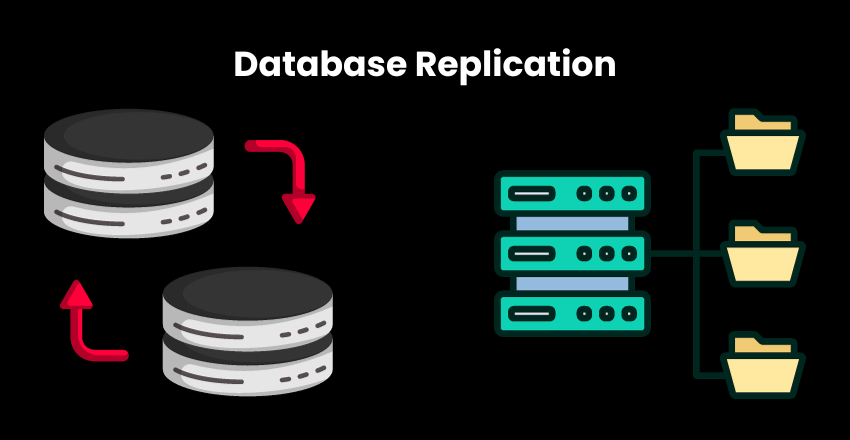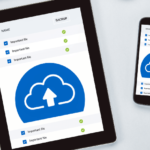
Database replication copies and distributes data from a source database to one or more replica databases, ensuring high availability and improved performance at scale.
It’s an essential process for ensuring data redundancy and accessibility. It involves duplicating data across multiple database servers, providing a backup in case of system failure. With database replication, businesses can ensure that data is always available, regardless of computer crashes or unforeseen events.
Replication methods can vary, but the most popular options include synchronous and asynchronous replication. Snapshot and transactional replication are additional approaches that businesses can use depending on their needs and goals.
Key Takeaways:
- Database replication ensures data redundancy and accessibility in case of system failure.
- Popular replication methods include synchronous, asynchronous, snapshot, and transactional replication.
Understanding Database Replication
Database replication refers to the process of creating and maintaining duplicate copies of a database on multiple servers. This technique ensures data redundancy, which means that even if one server fails or experiences downtime, the data remains accessible and available on other servers.
Database replication is an essential aspect of database management as it ensures the availability and accessibility of data for mission-critical applications. It is used to improve the performance of applications, ensure disaster recovery, and streamline data backup and recovery processes.
Benefits of Database Replication

Database replication provides numerous benefits, including:
- Improved Data Availability: Replication ensures that multiple copies of data are readily available, reducing the risk of unexpected downtime and ensuring continuous access to critical data.
- Disaster Recovery: In case of disaster, replicated data ensures that a backup is available, allowing for efficient data restoration and resumption of operations.
- Increased Performance: Replication can improve performance by distributing database read requests across multiple servers, reducing the workload on individual servers and ultimately improving response times.
By ensuring data redundancy, database replication provides businesses with a reliable and efficient way of maintaining data availability, minimizing disaster recovery time, and optimizing database performance.
If you are planning to implement database replication, HireSQL can provide dedicated SQL developers with experience in replicating data across different servers and managing the process effectively.
Types of Database Replication Methods
Database replication refers to the process of copying data from one database to another to ensure data redundancy. To achieve this, there are different replication methods available, which are:
| Replication Method | Description |
|---|---|
| Synchronous Replication | Requires that data is copied to all replica databases simultaneously. This method is costly as it requires high network bandwidth and low latency to ensure that all databases are up-to-date at all times. It is ideal for systems that cannot tolerate any data loss. |
| Asynchronous Replication | Data is copied to the replica databases with a delay. This method is less resource-intensive than synchronous replication and provides better performance. However, data loss may occur in the event of a failure. |
| Snapshot Replication | This method involves taking periodic snapshots of the database at a specific point in time and copying them to the replica databases. This approach is useful if the system can tolerate some level of data loss. |
| Transactional Replication | It involves replicating only specific data changes that occur on the primary database to the replica databases. This method is suitable for large databases that have infrequent changes and require low latency. |
In practice, a combination of these methods may be used to achieve the desired level of data redundancy and performance.
Here is an example SQL statement that creates a transactional replication publication:
CREATE DATABASE AdventureWorks2017; USE AdventureWorks2017; EXEC sp_addpublication @publication = 'AdventureWorks2017', @status = 'active';
This code creates a publication named “AdventureWorks2017” and sets its status as active. This publication can now be used to replicate data changes to the subscriber databases.
Configuring Database Replication

Before setting up database replication, it is important to understand the database system’s replication requirements and choose the appropriate replication method. Once that is done, follow the step-by-step guide below to configure database replication:
- Configure the replication topology by determining the number of replication nodes required to achieve the desired level of redundancy.
- Define the replication schema, i.e., what data will be replicated and in what manner.
- Specify the replication method and configure the replication agents accordingly.
- Configure the failover mechanism to ensure high availability in the event of a primary server failure.
- Configure the security policies to ensure data privacy during replication.
- Perform initial replication to synchronize data across all nodes.
When configuring database replication, it is important to consider the following:
- Network bandwidth and latency
- Replication performance impact on the primary server
- Replication performance impact on the target servers
- Failover time and impact on the application
- Security requirements
It is recommended to use automation tools to simplify the replication configuration process and ensure consistency across all replication nodes.
SQL Server Management Studio (SSMS) provides a wizard for configuring database replication, which significantly reduces the manual effort required to set up database replication.
Ensuring Data Consistency in Replicated Databases
One of the primary challenges in maintaining replicated databases is ensuring data consistency. When data is replicated across multiple servers, it’s essential to ensure that the same data is available across all servers. Inconsistencies can result in data corruption and lead to various problems, including incorrect reports, missing records, and even financial losses.
Write conflicts resolution:
One technique to maintain data consistency is to address write conflicts. Write conflicts occur when multiple users attempt to update the same record simultaneously. In such cases, the system must have a mechanism to handle the conflicting changes. Several approaches can be used to resolve write conflicts, including timestamp-based and version-based methods.
Consistency checks:
Consistency checks are a vital part of maintaining data consistency in replicated databases. These checks verify that the data across all servers is consistent and up-to-date. Consistency checks should be run regularly to ensure that the data remains accurate and reliable. SQL code examples for consistency checks can be found on our website.
Monitoring and Managing Database Replication

Databases are critical components of most software systems, and downtime or data loss can have significant business impact. That’s why it is important to monitor and manage database replication to ensure the replication is happening seamlessly. While most replication methods are designed to work without human intervention, there are certain factors that need to be managed for optimal data redundancy and accessibility.
Database replication monitoring is done to ensure that all the replication nodes are up and running, and replication is happening smoothly without any errors. Replication monitoring tools identify and alert administrators of potential issues, helping them take timely action. These tools can also generate reports that provide insights into replication performance and identify potential bottlenecks.
Replication Monitoring Tools
There are various tools available for monitoring and managing database replication, including:
| Tool | Description |
|---|---|
| SQL Server Management Studio | A Microsoft tool used to monitor and manage SQL Server replication. |
| Oracle Enterprise Manager | An Oracle tool used to manage and monitor database replication. |
| Nagios | An open-source tool that monitors network infrastructure, servers, and services. It can be configured to monitor replication status. |
Database replication management involves verifying that the replication configurations are in sync across all replication nodes. It includes tasks such as adding or removing replication nodes, configuring replication settings, and setting up replication alerts. It is also important to perform regular maintenance tasks such as backing up the databases to ensure data availability in the event of a disaster.
Database replication management can be done using various tools including:
| Tool | Description |
|---|---|
| SQL Server Management Studio | A Microsoft tool used to monitor and manage SQL Server replication. |
| Oracle Enterprise Manager | An Oracle tool used to manage and monitor database replication. |
| SQL Server Agent | A scheduling and management service for SQL Server used to automate administrative tasks. |
Regular monitoring and management of database replication is essential for ensuring data redundancy and accessibility. By using the right tools and techniques, administrators can identify and resolve replication issues before they become critical.
Scaling Database Replication for Growth
As your business grows, so does the amount of data you need to manage. Scaling your database replication is essential to ensure that your system can handle the increased demand for data.
One strategy for scaling database replication is to add additional replication nodes. By adding additional nodes, you can distribute the workload and reduce the risk of data loss in case one node fails. This also ensures that your system can handle larger volumes of data without sacrificing performance or availability.
Another strategy is to implement load balancing. Load balancing ensures that the workload is evenly distributed across all available nodes, which can greatly improve performance and reduce the risk of downtime. This is especially useful when dealing with high-traffic applications or large volumes of data that require fast processing times.
When implementing these strategies, it’s important to consider the potential impact on your system’s performance and capacity. You may need to invest in additional hardware or upgrade your existing infrastructure to accommodate the increased demand for data.
Here’s an example of SQL code for adding a replication node:
EXEC sp_addserver 'NodeName', 'replication';
By following these best practices and strategies, you can effectively scale your database replication to accommodate your growing business needs.
Challenges and Considerations in Database Replication

While database replication has numerous benefits, there are also some challenges and considerations that must be taken into account before implementing it. These include:
- Network Latency: Latency can cause delays in data transfer between servers, which may impact the efficiency of the replication process. It’s important to factor in network latency while configuring replication for optimal performance.
- Data Conflicts: Replication involves duplicating data across multiple servers, which can result in write conflicts, especially in cases where data is updated simultaneously on multiple servers. To mitigate this issue, it’s important to implement a conflict resolution strategy that prioritizes data consistency.
- Bottlenecks: Replication can also create bottlenecks in the database system, particularly when large amounts of data need to be replicated across multiple servers. This can impact the performance of the entire system. To avoid this issue, it’s recommended to use a load-balancing approach that distributes the replication load evenly across all servers.
- Security: Data replication involves transferring critical data across multiple servers, which increases the risk of security breaches. It’s essential to implement adequate security measures, including data encryption and access controls, to protect the data from unauthorized access.
- Data Consistency: Maintaining data consistency can be a challenge, especially when multiple copies of the same data exist across different servers. To ensure data consistency, it’s important to configure replication settings that allow the system to check for consistency regularly.
In addition to the challenges listed above, other considerations, such as cost, system complexity, and maintenance requirements, must also be taken into account while implementing database replication. By addressing these challenges and considerations, you can ensure that your database replication strategy is effective and reliable.
Database Replication Best Practices

Implementing database replication can provide numerous benefits for data redundancy, improved availability, and disaster recovery. However, it is crucial to follow best practices to ensure its effectiveness and optimize performance.
Here are some best practices for implementing database replication:
- Define and prioritize replication goals and requirements.
- Choose the appropriate replication method based on your database system and business needs.
- Perform regular health checks and maintenance on your replication nodes to ensure they are functioning correctly.
- Monitor the replication status and performance to identify and resolve any issues promptly.
- Implement security measures such as SSL encryption and access control to protect data integrity and confidentiality.
- Regularly test your replication system to ensure data consistency and reliability.
- Document your replication configuration and processes for future reference and maintenance.
In addition to these general best practices, it is essential to tailor your replication strategy to your specific use case and system requirements. You may consider consulting with a dedicated SQL developer from HireSQL to provide expert guidance for your database replication needs.
Here is an example of SQL code for implementing database replication:
CREATE DATABASE repdb; USE repdb; CREATE TABLE example_table LIKE source.example_table; INSERT INTO example_table SELECT * FROM source.example_table;
By following these best practices, you can ensure a robust and reliable database replication system that provides seamless access to your critical data.
Conclusion
Database replication is a critical aspect of modern database management. By duplicating data across multiple servers, it ensures data redundancy and accessibility, making it an essential component of disaster recovery planning.
At HireSQL, our dedicated SQL developers are well-versed in database replication and can help organizations implement and manage it effectively. Contact us today to learn more about our services and how we can help your organization ensure data redundancy and accessibility through database replication.
FAQ

Q: What is database replication?
A: Database replication is the process of duplicating data across multiple database servers to ensure redundancy and improve data availability.
Q: Why is database replication important?
A: Database replication is important because it ensures data redundancy, allowing for seamless data access and backup in case of system failures or disasters.
Q: What are the benefits of database replication?
A: The benefits of database replication include improved data availability, disaster recovery capabilities, and increased performance.
Q: What are the types of database replication methods?
A: The types of database replication methods commonly used are synchronous and asynchronous replication, as well as snapshot and transactional replication.
Q: How can I configure database replication?
A: To configure database replication, you need to follow a step-by-step process that includes necessary configurations, considerations, and best practices.
Q: How can I ensure data consistency in replicated databases?
A: You can ensure data consistency in replicated databases by implementing techniques such as write conflicts resolution and consistency checks.
Q: How do I monitor and manage database replication?
A: Monitoring and managing database replication is crucial for its effectiveness. You can use tools and techniques to monitor replication status and troubleshoot common issues.
Q: How can I scale database replication for growth?
A: You can scale database replication for growth by adding additional replication nodes and implementing load balancing strategies.
Q: What are the challenges and considerations in database replication?
A: Challenges in database replication include potential bottlenecks, network latency issues, and data conflicts. Proper considerations need to be made to address these challenges.
Q: What are the best practices for database replication?
A: The best practices for database replication include ensuring data integrity, optimizing performance, and maintaining security.
External Resources
https://www.freecodecamp.org/news/understanding-database-scaling-patterns/
https://www.codecademy.com/article/database-scaling-strategies
https://www.mongodb.com/basics/scaling
Sarah is an accomplished author, esteemed for her expertise in the field of data science and her engaging written works that cater specifically to the data industry. Residing in the vibrant city of London, she embarked on an academic journey at Cambridge University, where she immersed herself in the world of mathematics. This foundational education formed the bedrock of her illustrious career.
Driven by a desire to broaden her horizons, Sarah sought new challenges and opportunities, leading her to embrace a pivotal role at NetApp, a renowned data storage consultancy firm. In this capacity, she thrived in the dynamic landscape of data architecture, devising innovative strategies to optimize data storage, retrieval, and management for a diverse range of clients. Sarah’s intricate understanding of the intricacies of data systems and her ability to craft tailor-made solutions earned her accolades and solidified her reputation as a sought-after industry expert.
Beyond her professional pursuits, Sarah gracefully balances her roles as a devoted mother and an accomplished equestrian. She finds immeasurable joy in nurturing her daughter, guiding her through the intricacies of life, and instilling a love for knowledge and creativity. Sarah’s dedication to both her family and her career exemplifies her unwavering commitment to excellence in all facets of life.







